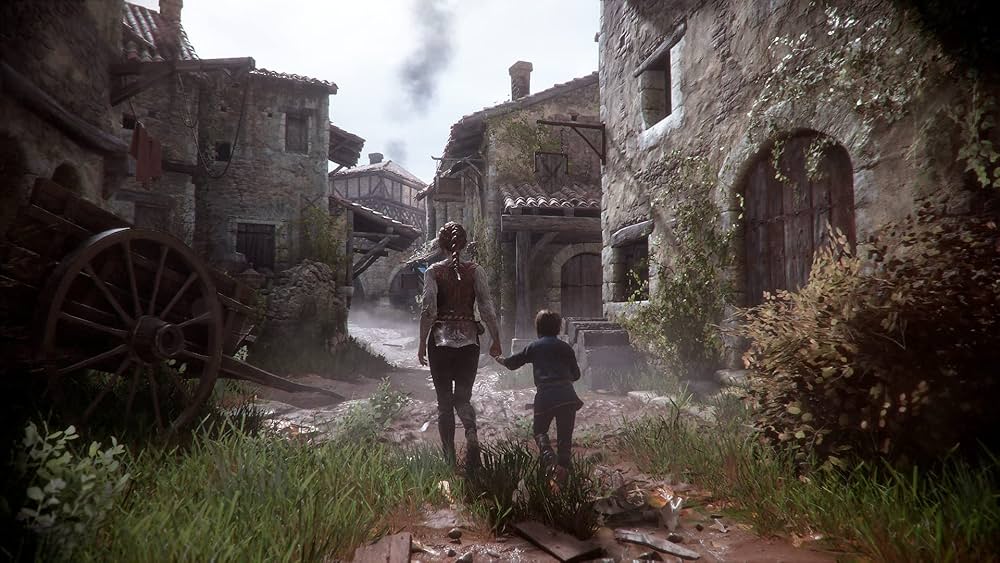Introduction to A Plague Tale: Innocence
A Plague Tale: Innocence, developed by Asobo Studio and published by Focus Home Interactive, is a unique action-adventure game that takes players on a haunting journey through 14th-century France. Released in May 2019, the game follows the story of two siblings, Amicia and Hugo de Rune, as they navigate a world ravaged by war, the Black Death, and swarms of plague-infested rats. With its deeply emotional narrative, stunning visuals, and compelling stealth gameplay, A Plague Tale: Innocence has earned its place as one of the most memorable story-driven games of its time.
Setting and Atmosphere
14th-Century France: A Land in Crisis
The game is set during the Hundred Years’ War between France and England, as well as the outbreak of the bubonic plague. These historical events serve as the backdrop for the narrative, immersing players in a grim, war-torn world. The game captures the bleak atmosphere of medieval France with its dilapidated villages, haunting countryside, and death-stricken streets, giving players a visceral sense of the horrors the era brought.
The Plague and the Rats
The plague in A Plague Tale: Innocence is not just a historical reference but a literal force of nature within the game. Swarms of aggressive, plague-carrying rats flood the environment, acting as a constant threat to Amicia and Hugo. These rats, while terrifying, are also cleverly incorporated into puzzles and stealth gameplay, making them central to the overall experience.
Gameplay Mechanics
Stealth and Strategy
A Plague Tale: Innocence primarily focuses on stealth gameplay, requiring players to outwit both human and environmental enemies. Combat is not a primary option, as Amicia and Hugo are not trained fighters. Instead, the game encourages players to use their surroundings and tools to evade or distract enemies. The gameplay is less about action and more about careful planning and execution, which fits the narrative of two vulnerable children trying to survive in a hostile world.
Puzzle Elements
Puzzles are a key aspect of A Plague Tale: Innocence. Whether it’s finding a way to navigate through a swarm of rats or manipulating the environment to move forward, players must use their wits to progress. These puzzles are often tied to the game’s light mechanics, as rats fear fire and light. Managing torches, lamps, and other sources of illumination becomes crucial for survival.
Crafting and Resource Management
Amicia can craft various tools and weapons to help her and Hugo survive. By collecting resources throughout the game, players can create items like firebombs or alchemical mixtures to manipulate the environment and fend off enemies. This crafting system adds another layer of strategy, as resources are scarce, forcing players to make careful decisions about when and how to use them.
Story and Characters
Amicia and Hugo de Rune
At the heart of A Plague Tale: Innocence is the bond between Amicia, a teenage girl, and her younger brother Hugo. The story begins with Amicia being thrust into the role of protector after their home is attacked by the Inquisition. As the siblings flee, Amicia must care for Hugo, who has been sheltered due to a mysterious illness. Their relationship evolves over the course of the game, growing from distant siblings to a strong, interdependent duo.
The emotional depth of their bond is a central theme, with players experiencing the challenges of protecting a vulnerable child in such a dangerous world. Hugo’s illness becomes a significant plot point, intertwining with the game’s supernatural elements.
The Inquisition and Other Villains
The Inquisition serves as one of the main antagonists in A Plague Tale: Innocence. Led by Lord Nicholas, the Inquisition is determined to capture Hugo due to his mysterious condition, believing it holds great power. The ruthless nature of these enemies adds an additional layer of tension, as they are relentless in their pursuit of the siblings.
Alongside the Inquisition, the game also features other enemies, including mercenaries, soldiers, and wild animals, all of whom contribute to the constant danger faced by Amicia and Hugo.
Visuals and Audio
Stunning Visual Design
The visual design of A Plague Tale: Innocence is nothing short of breathtaking. The game’s environments are beautifully rendered, from the eerie glow of torch-lit tunnels to the vast, plague-stricken landscapes. The attention to detail in character models, historical architecture, and the unsettling rat swarms creates a world that feels both immersive and oppressive.
The use of light and shadow is also integral to the gameplay and storytelling, with certain areas bathed in sunlight offering safety, while dark, rat-infested areas are fraught with danger. This dynamic contrast helps build tension and guides players through the story’s progression.
Emotionally Charged Soundtrack
The game’s soundtrack, composed by Olivier Deriviere, is a standout element of A Plague Tale: Innocence. The music perfectly complements the emotional weight of the story, with haunting melodies and tense orchestral pieces that elevate key moments. The voice acting is equally powerful, particularly the performances of Amicia and Hugo, whose emotional journeys are brought to life through their dialogue.
Themes and Symbolism
Survival and Innocence
One of the central themes of A Plague Tale: Innocence is the loss of innocence in the face of adversity. Amicia and Hugo, both children, are forced to grow up quickly as they navigate a world of death, despair, and danger. The game constantly challenges them, testing their resilience and their bond as siblings. The title itself reflects this, as the characters must fight to preserve their innocence while surviving the horrors around them.
Light vs. Darkness
Light plays a symbolic role throughout the game. It represents safety, hope, and life, while darkness signifies fear, death, and the unknown. This dichotomy is not only present in the game’s mechanics but also in its narrative, where characters seek light, both literally and figuratively, in a dark, collapsing world.
Reception and Impact
Critical Acclaim
A Plague Tale: Innocence received widespread acclaim upon its release. Critics praised its narrative depth, character development, and atmospheric world. The emotional journey of Amicia and Hugo struck a chord with many players, and the game was lauded for its fresh take on the action-adventure genre. Its ability to blend historical realism with elements of fantasy and horror earned it numerous accolades and award nominations.
Legacy and Influence
The success of A Plague Tale: Innocence paved the way for its sequel, A Plague Tale: Requiem, further expanding the story of Amicia and Hugo. The game also left a mark on the industry by showcasing how smaller studios can deliver narrative-driven experiences that rival those of larger, AAA titles. Its focus on emotional storytelling and its innovative use of historical settings have inspired other games in the genre.
Conclusion
A Plague Tale: Innocence is a masterfully crafted game that excels in storytelling, atmosphere, and emotional depth. It offers a unique blend of stealth, puzzle-solving, and resource management, all while delivering a poignant narrative about survival, family, and the loss of innocence. The bond between Amicia and Hugo lies at the heart of the game, and their journey through a plague-ridden world is one that players will not soon forget.
With its haunting visuals, emotionally charged soundtrack, and immersive gameplay, A Plague Tale: Innocence is a must-play for fans of narrative-driven games. It stands as a testament to the power of storytelling in gaming and remains one of the most memorable titles of the last decade.


